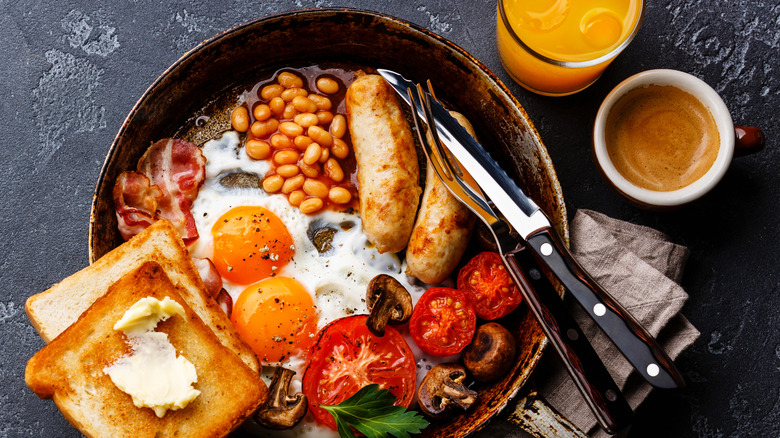Why Tomatoes Are A Necessity When It Comes To A Full English Breakfast
A full English breakfast, or fry-up, is as iconic and treasured a culinary tradition as fish and chips or a Sunday roast. Hearty to say the least, a full English breakfast consists of fried runny eggs, baked beans, bacon, sausage, black pudding, fried bread, mushrooms, and tomatoes. If you think tomatoes are thrown in as an afterthought, think again. Tomatoes are a necessity when it comes to a full English breakfast because they bring much-needed balance.
Tomatoes are light, juicy, and acidic, which helps to cut through the richness of all the greasy fried pork items and complement the sweetness in the baked beans. A burst of juiciness is a great textural contrast to the meaty chew of bacon, sausage, and black pudding. Aesthetically, tomatoes provide a pop of color, while their umami-rich flavor only enhances the savoriness of the meat and eggs. Many full English breakfast recipes recommend grilling tomatoes to further enhance their juiciness while also adding a sweet and smoky depth to their flavor profile. You can also fry them up in a skillet like the rest of the ingredients, halved and cut side down with a sprinkle of salt and pepper.
History and variations on the full English breakfast
The full English breakfast originated centuries ago as a high-society meal only the aristocracy could enjoy. The recipe as we know it today appears in cookbooks and written documents during the mid 19th century. Wealthy aristocrats would have the cooking staff prepare these lavish breakfasts at their large country estates to serve friends and family before a long day of hunting. This time period also coincided with the Industrial Revolution which helped make goods more available to working classes. This helped create a larger middle-class, and they also took to the English breakfast craze. After the second World War, a full English breakfast was a daily staple for 1950s middle class Brits.
Today, a full English breakfast is less of a daily meal and more of a luxurious weekend brunch. But its popularity has reached all the British isles as well as Hong Kong and the U.S. You'll find it on the breakfast menu at most traditional restaurants and even as an all-day breakfast item in England. Different countries have added their own culinary signatures to the dish. For example, Irish fry ups use famous soda bread instead of standard white toast. An Irish fry up also uses white pudding instead of blood pudding and adds boxty, a traditional Irish potato pancake. The Scottish fry up features the national dish, haggis, and potato scones, while the Welsh use their traditional seafood and oatmeal fry bread to accompany the meat, eggs, beans, and veggies.

